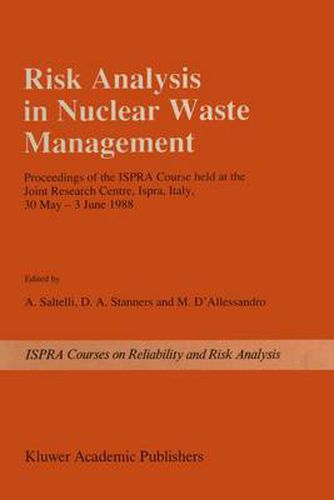Readings Newsletter
Become a Readings Member to make your shopping experience even easier.
Sign in or sign up for free!
You’re not far away from qualifying for FREE standard shipping within Australia
You’ve qualified for FREE standard shipping within Australia
The cart is loading…






—– One of the arguments most frequently raised by objectors to nuclear power production is the spectrum of the hazard from the nuc.lear waste. In the public’s perception one of the most dangerous features of this waste is the threat to future generations due to the long life of the radio-emitting nuclides. People’s concern for this hazard seems to be greater than that for other types of toxic wastes, widely produced and released to the environment (heavy metals, PCBs, arsenic etc.) though these might last even longer. In fact public attitude toward risk depends very strongly on the nature of the risk, as clearly illustrated ill the initial papers of these proceedings. On this basis it appears that tile safety of the nuclear practice, including waste disposal, cannot be assessed only by comparison with other practices or risks. For this reason the analysts have accepted the challenge of investigating the long term safety of this type of waste, taking it much further than for many other known pollution problems affecting mankind. Moreover, for one of the first times lhis is being dulle IJi2fure disp,)sal. The c,)ntributiolls tu these pruceedillljs attempt to describe the specific nature of this type of assessment, pi esent ing Ilew developments which have been made in the field. These include the recourse to system variability analysis, the use of natural and archaeulugical analogues and predictive geology.
$9.00 standard shipping within Australia
FREE standard shipping within Australia for orders over $100.00
Express & International shipping calculated at checkout
—– One of the arguments most frequently raised by objectors to nuclear power production is the spectrum of the hazard from the nuc.lear waste. In the public’s perception one of the most dangerous features of this waste is the threat to future generations due to the long life of the radio-emitting nuclides. People’s concern for this hazard seems to be greater than that for other types of toxic wastes, widely produced and released to the environment (heavy metals, PCBs, arsenic etc.) though these might last even longer. In fact public attitude toward risk depends very strongly on the nature of the risk, as clearly illustrated ill the initial papers of these proceedings. On this basis it appears that tile safety of the nuclear practice, including waste disposal, cannot be assessed only by comparison with other practices or risks. For this reason the analysts have accepted the challenge of investigating the long term safety of this type of waste, taking it much further than for many other known pollution problems affecting mankind. Moreover, for one of the first times lhis is being dulle IJi2fure disp,)sal. The c,)ntributiolls tu these pruceedillljs attempt to describe the specific nature of this type of assessment, pi esent ing Ilew developments which have been made in the field. These include the recourse to system variability analysis, the use of natural and archaeulugical analogues and predictive geology.